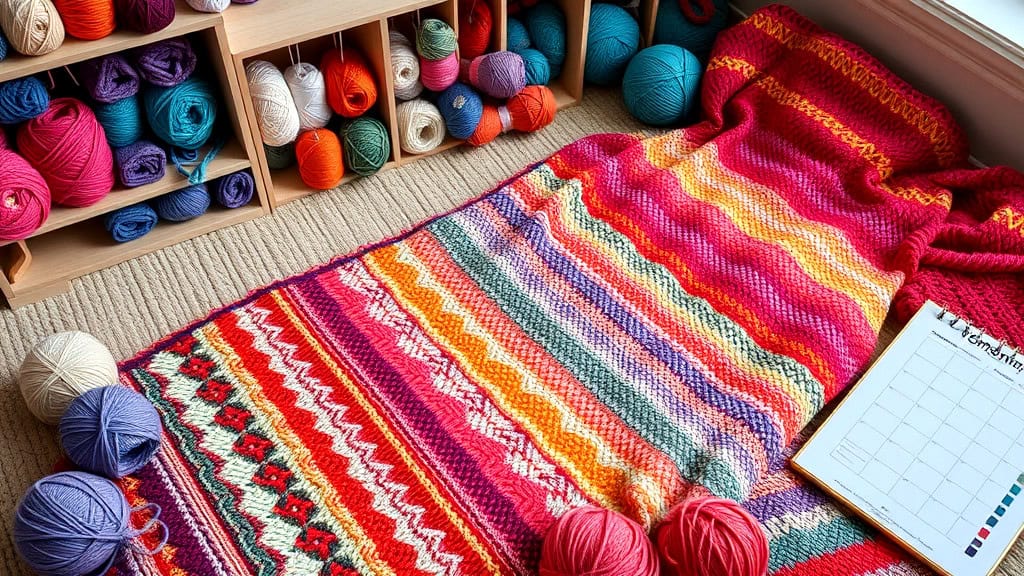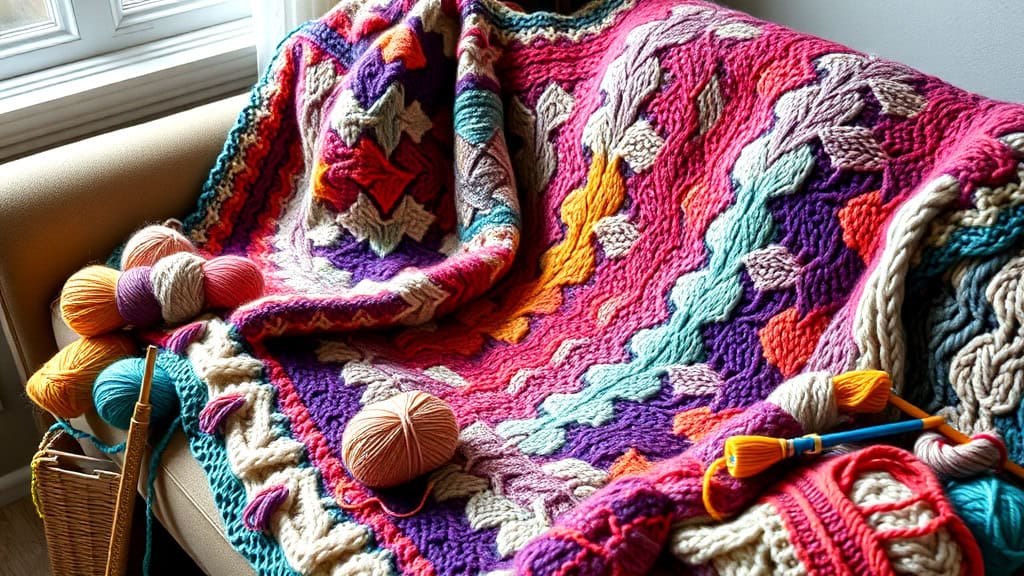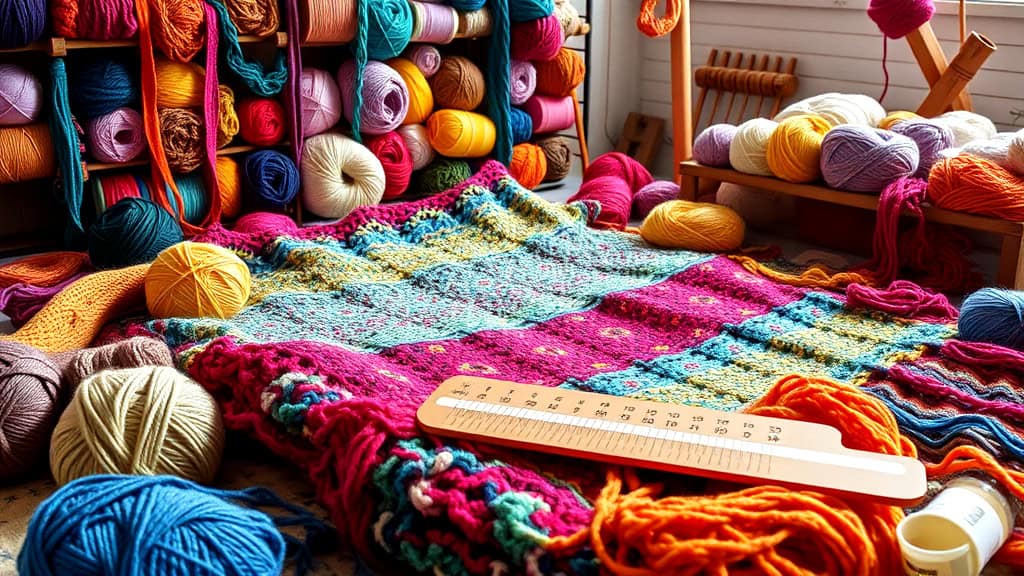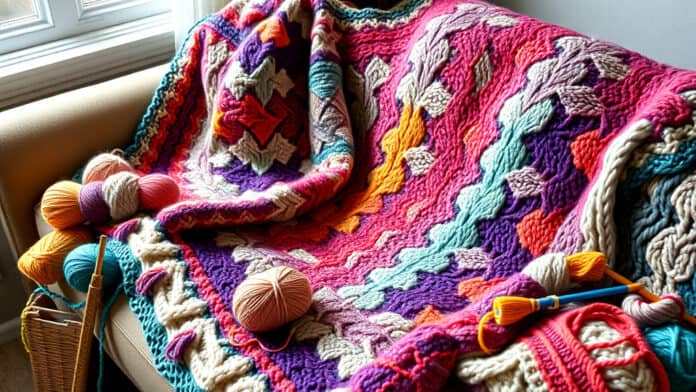Creating Patterns In Knitting With Many Colors
Knitting a pattern with many colors isn’t just about creating something beautiful; it’s a colorful adventure. When you decide to knit with multiple yarn colors, you open up a canvas for endless creativity. Think of it as painting, but instead of brushes, you have needles. And the result? A masterpiece that keeps you warm.
Choosing the right shades is like picking the perfect palette for a painting. It’s not just about picking your favorites; it’s about how those colors work together. Whether it’s a temperature blanket or a cozy scarf, each color tells a part of the story. And when it comes to a temperature blanket knitting project, each hue marks a memory, a day, or even a feeling.
Now, let’s talk techniques. Stranded or intarsia? Each method adds its own texture and depth to your project. And for those of you tackling a temperature blanket project, managing those yarns can be like directing an orchestra. Each strand, a note; together, they create a symphony of colors.
But, it’s not just about following a pattern. It’s about making it your own. Add a twist to your blanket knitting project with a splash of unexpected color or a surprise element from Native American basketry. The history and stories behind the Native American tribes can inspire patterns that are not just beautiful but meaningful.
And don’t forget, every knitter’s secret weapons: the single crochet and turning chain. These fundamentals can transform your work from “just another blanket” to a free temperature blanket pattern that others will ask about. So, grab your grid designer and let’s start this color-filled adventure. Your needles are your wand, ready to cast a spell of colors.
Key Takeaways
- Selecting yarn colors that complement each other is critical for a visually stunning temperature blanket.
- Stranded knitting and intarsia techniques each offer a distinct method for adding intricate designs to your project.
- Using a grid designer can simplify the process of planning your colorwork, especially for complex patterns like a temperature blanket knitting project.
- Tools like bobbins are invaluable for keeping multiple yarn colors organized, preventing tangles and confusion.
- Incorporating single crochet and turning chain methods can add a professional touch to your blanket knitting project, making it stand out.

Choosing the Right Yarn Colors
Selecting the perfect yarn colors is a game-changer in the art of creating patterns in knitting with many colors. A harmonious palette can turn a simple knit into an eye-catching masterpiece. Think of your knitting project as a canvas where every stitch is a pixel of color.
For those embarking on a temperature blanket project, the choice of hues is even more poignant. Each color represents a range of temperatures, weaving a story of climatic change over time. It’s like a diary in yarn form, capturing fleeting moments through the language of colors. The trick is to choose shades that not only represent temperature shifts accurately but do so in a way that’s visually appealing.
To tackle a temperature blanket knitting task, consider employing a grid designer. This tool acts as a blueprint, mapping out your project’s color transitions with precision. It’s like having GPS for your knitting needles, guiding you through the maze of color changes without getting lost.
A temperature blanket project is more than just knitting; it’s an exploration of hues. Mixing varying shades and textures adds depth and interest to your work. For instance, combining matte and shiny yarns can create a mesmerizing effect that brings your temperature blanket to life.
Now, let’s talk technique. Stranded knitting allows for a rich tapestry of colors to coexist on the same row, perfect for intricate patterns. Meanwhile, intarsia knitting shines in blocks of color, making it ideal for bold, graphical designs. Both methods are pillars in the temple of colorwork knitting, each with its own set of rituals to master.
For those who prefer the tactile satisfaction of crochet, integrating single crochet and turning chain techniques can introduce texture into your temperature blanket. It’s like adding spices to a dish; a little can go a long way in transforming the final outcome.
Managing multiple yarn colors without tangling or losing tension is a skill honed over time. Bobbins become your best friends, keeping each color of yarn neatly separated and ready at a moment’s notice. It’s akin to organizing a spice rack; everything has its place, making the cooking process smoother and more enjoyable.
Experimentation is the soul of creativity. Don’t be afraid to play with color combinations outside of conventional wisdom. Sometimes, the most stunning visuals come from unexpected pairings. It’s the knitting equivalent of discovering a new favorite flavor by mixing ingredients you never thought to combine.
Numeric List for Managing Yarn Colors in Multi-Colored Knitting Projects:
- Use a color wheel to select complementary shades.
- Employ a grid designer for complex patterns.
- Organize yarns with bobbins to prevent tangling.
- Knit gauge swatches to test color transitions.
- Experiment with textures and sheens for depth.
- Block finished pieces to highlight colorwork.
- Remember, every mistake is a learning opportunity.
Table: Yarn Selection for Temperature Blankets
| Temperature Range (°F) | Yarn Color | Texture | Weight |
|---|---|---|---|
| Below 32 | Ice Blue | Matte | DK |
| 33-50 | Soft Green | Shiny | Worsted |
| 51-70 | Warm Yellow | Matte | Sport |
| 71-85 | Bright Red | Shiny | Fingering |
| Above 85 | Orange Flame | Matte | Bulky |
Through these guidelines, your knitting project can transform from a simple hobby into a vivid narrative, one stitch at a time. Remember, the beauty of knitting lies not just in the finished product but in the joy of the creative process itself. So grab your needles, and let’s paint with yarn.
Essential Colorwork Techniques Explained
Unraveling the secrets behind creating patterns in knitting with many colors isn’t as tangled as it might seem. Choosing the right yarn colors plays a pivotal role in the outcome of your project. Think of your knitting as a canvas where contrasts create the masterpiece. Mixing textures and sheens can add a layer of depth, making the patterns pop. For colorwork, sport and fingering weights are your best bets to keep designs clean and detailed.
Diving into the heart of colorwork techniques, let’s talk about stranded and intarsia knitting. Stranded knitting is your go-to for keeping multiple colors active across a row, tucking the unused yarn neatly behind your work. Intarsia, on the other hand, allows for large blocks of color without carrying yarn across the back, perfect for that bold, graphic statement. Both methods demand a bit of juggling with yarns but fear not, practice makes perfect.
For those embarking on a temperature blanket project, it’s a fantastic way to weave a story through hues. The temperature blanket knitting process involves assigning yarn colors to temperature ranges, creating a year-long visual diary. A temperature blanket is not just a cozy wrap but a conversation starter, draped over your sofa.
When tackling multiple yarns, tension is the name of the game. A consistent hand ensures even stitches and a smooth fabric. Tools like stitch markers and row counters can be lifesavers, especially when patterns get intricate. And let’s not forget blocking. It’s like giving your project a spa day, relaxing all those stitches into their best selves.
Experimentation is your friend here. Mix and match techniques for a free temperature blanket pattern that tells your tale. Whether you’re a fan of the crisp geometries afforded by stranded knitting or the bold, pictorial narratives possible with intarsia, there’s a technique to match your vision.
A grid designer might become your new best buddy, especially for personalized projects. These handy tools help translate your ideas into knittable patterns. And for a touch of history, why not incorporate color schemes inspired by England Native American tribes? Their rich traditions can add meaningful layers to your work.
Managing multiple yarn colors is akin to conducting an orchestra. Each strand plays its part, contributing to the symphony of stitches unfolding under your fingers. Remember, every knitter has their rhythm; find yours and the yarn will dance to your tune.
Whether it’s the rhythmic single crochet or the foundational turning chain, each stitch tells a story. And for those who dare, the single crochet graphghan technique opens up a universe of pixelated possibilities.
So, grab your needles (or hook), a palette of yarn colors, and cast on. Your next knitting project could be the tapestry that weaves together technique, tradition, and personal touch. After all, each stitch is a pixel in the fabric of your creative expression.

Mastering Stranded and Intarsia Knitting
To excel in the art of knitting with multiple colors, one must grasp the nuances of stranded and intarsia techniques. Achieving mastery here sets the foundation for creating patterns in knitting with many colors, opening up a kaleidoscope of possibilities. Whether you’re embarking on a temperature blanket knitting project or adding colorful motifs to your designs, the choice of yarn colors plays a pivotal role.
Selecting the right shades involves more than just picking your favorites. Contrast and harmony need to coexist, allowing each color to pop without overwhelming the others. For a temperature blanket, this means assigning a spectrum of yarn colors to reflect different temperature ranges—a creative and visually compelling way to document the year’s weather patterns.
When juggling multiple strands, organization is your best friend. Using bobbins for intarsia or learning to weave in ends as you go with stranded knitting can keep your workspace tidy and your mind clear. And don’t forget the importance of a grid designer tool. It’s like having a map in a city; it guides you where you need to go without getting lost in the alleys of color changes.
Now, onto the practical side of things. Here’s a list to keep you on track:
- Choose a temperature blanket yarn that represents the desired temperature ranges.
- Utilize a grid designer to plot out your design beforehand.
- Practice the single crochet; it’s a staple for many colorwork projects.
- Don’t skip the turning chain, it keeps your edges neat.
- Experiment with a single crochet graphghan for pixelated portraits.
- Keep tension consistent to avoid puckering or gaps.
- Block your work to smooth out any inconsistencies.
Creating a table to organize your project can be immensely helpful. Here’s a simple one to get started:
| Technique | Yarn Type | Project Idea | Skill Level |
|---|---|---|---|
| Stranded | Wool | Sweater | Intermediate |
| Intarsia | Cotton | Wall Hanging | Advanced |
| Slip Stitch | Acrylic | Scarf | Beginner |
| Fair Isle | Blend | Hat | Intermediate |
| Mosaic | Silk | Bag | Advanced |
Remember, every knitting project is a blanket knitting project in spirit. It’s about wrapping yourself or someone else in the warmth of your effort and creativity. Whether it’s a free temperature blanket pattern you found online or an original design, what matters most is the joy found in the making.
So, take a leap into the colorful pool of yarn. Let your needles be the brush, and your yarn colors the paint. There’s a masterpiece waiting to be knitted, stitch by colorful stitch. Just remember, every knitter was once a beginner. Mistakes are just unpulled loops in the fabric of learning. Now, go make your rainbow!

Tips for Managing Multiple Yarn Colors
When it comes to juggling multiple yarn colors for your next knitting masterpiece, a few tried-and-true strategies can make your process smoother and your patterns pop. Creating patterns in knitting with many colors doesn’t have to be a tangled affair. With the right approach, every stitch can contribute to a visually striking result, whether you’re working on a temperature blanket or a complex graphghan.
One of the golden rules is to keep your yarn organized. Assign a dedicated spot for each color. This could be as simple as arranging them in order of use or as sophisticated as using a grid designer for precision in complex patterns. A clear workspace equals a clear mind—and fewer knots in both your yarn and your stomach.
Another tip is maintaining an even tension. This is especially critical in projects like the temperature blanket, where the beauty lies in the smooth gradient of colors reflecting changes in temperature. Practice consistent stitches by starting with smaller projects. It’s like training wheels for your hands until they learn the rhythm.
Speaking of rhythm, let’s talk about the dance of changing colors. Whether you’re inserting a fiery red for a hot summer day in your temperature blanket knitting or a cool blue for a chilly winter evening, the trick is in the twist. Always twist your yarns on the wrong side of your project to avoid unsightly holes. It’s a bit like ballet—graceful on the surface but a lot of intricate footwork behind the scenes.
| Technique | Use Case | Pro Tip |
|---|---|---|
| Stranded | For carrying colors across a row. | Use bobbins to manage yarns and prevent tangling. |
| Intarsia | For large blocks of color. | Twist yarns at changes to secure the work. |
| Fair Isle | For detailed, multi-colored patterns. | Keep floats short to avoid puckering. |
| Slip Stitch | To add texture with minimal color changes. | Perfect for subtle colorwork without the hassle. |
| Single Crochet | For tight, dense fabric in graphghans. | Use a smaller hook to keep your stitches neat. |
For those special projects like a temperature blanket project, consider the single crochet technique for a snug, warm fabric that accurately charts the highs and lows of your chosen period. And don’t forget the turning chain; it’s the unsung hero that keeps your edges straight and your pattern accurate.
In the end, the joy of creating patterns in knitting with many colors comes from watching your project come to life, one hue at a time. Whether you’re weaving a temperature blanket or embarking on any blanket knitting project, remember: every stitch is a step on your creative voyage. So pick up those needles, choose your palette, and knit the rainbow you’ve always dreamed of. Just keep in mind, the best masterpieces start with a single stitch and a lot of heart.
Conclusion
Knitting with multiple colors isn’t just about making something beautiful. It’s about bringing a rainbow to your needles, stitch by stitch. When you pick the right yarn colors, it’s like choosing the perfect cast for a blockbuster movie. Each color has its role, and together, they create something unforgettable. And let’s be real, who doesn’t want their knitting project to be the star of the show?
Diving into colorwork techniques like stranded and intarsia knitting opens up a whole new knitting universe. It’s like learning a new language, but instead of words, you’re using yarns. Stranded knitting is like having a lively conversation with different colors, passing the yarn back and forth. On the other hand, intarsia is more like a well-organized debate, with each color standing its ground in its own block. Either way, you’re the director, orchestrating every stitch and color change.
Wrangling multiple yarn colors can be a bit like herding cats. But with a few tricks up your sleeve, like using bobbins and keeping a tight grip on tension, you’ll be leading the pack in no time. Remember, every masterpiece starts with that single stitch. So, dare to mix, match, and make mistakes. After all, every dropped stitch or tangled yarn is just a plot twist in your knitting adventure. Keep experimenting, and soon you’ll have a collection of knitted wonders that tell their own colorful stories.
FAQ
- How do I choose the right yarn colors for my project? Choose colors that contrast well. Think about texture and sheen too. Different yarn weights can add depth.
- What’s the difference between stranded and intarsia knitting? Stranded knitting involves carrying unused yarn behind your work. Intarsia uses separate blocks of colors, twisting yarns at changes.
- Can I mix knitting techniques in one project? Yes, you can mix techniques like Fair Isle, mosaic, and slip stitch for varied patterns. Get creative!
- Any tips for managing lots of yarn colors? Use bobbins to keep yarn from tangling. Practice maintaining tension for even stitches. Blocking helps too.
- Is colorwork knitting hard to learn? It has a learning curve, but with practice, you can create beautiful designs. Start with simpler patterns and build up.

